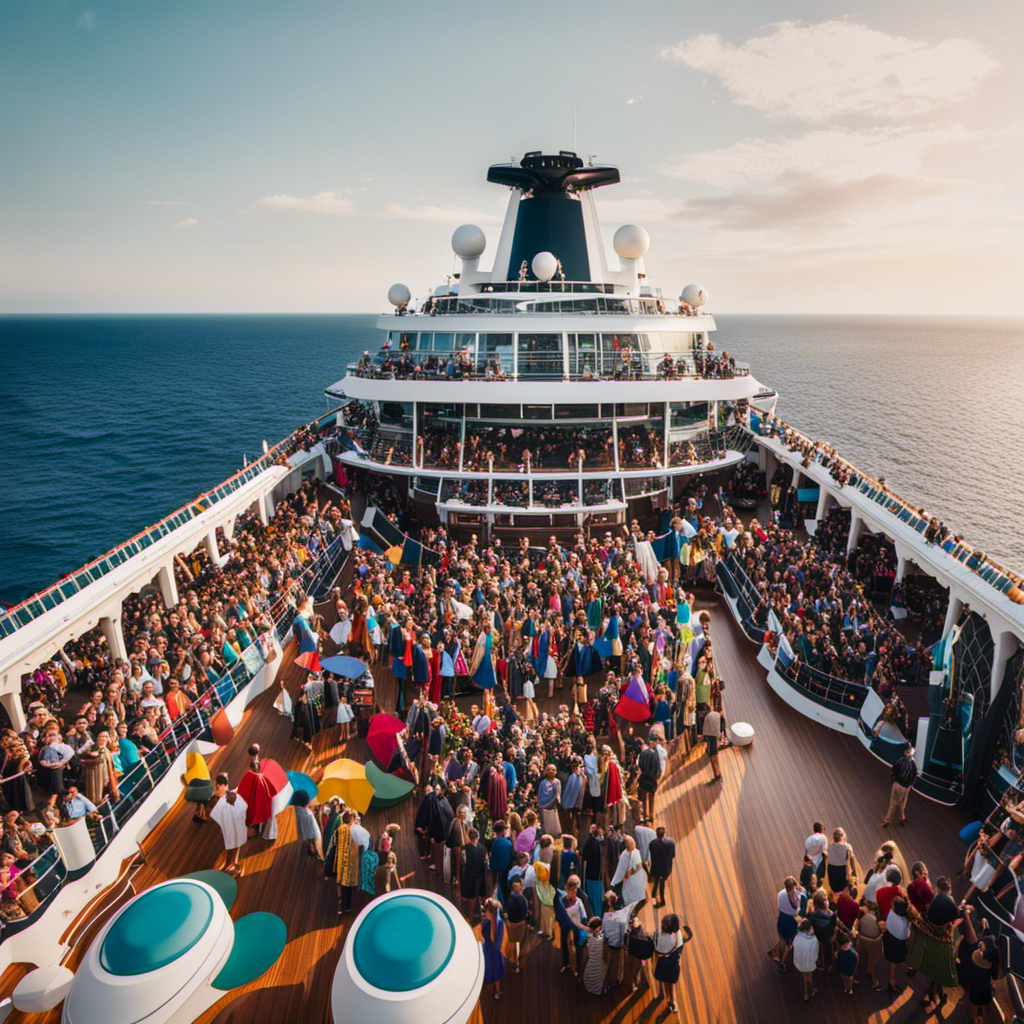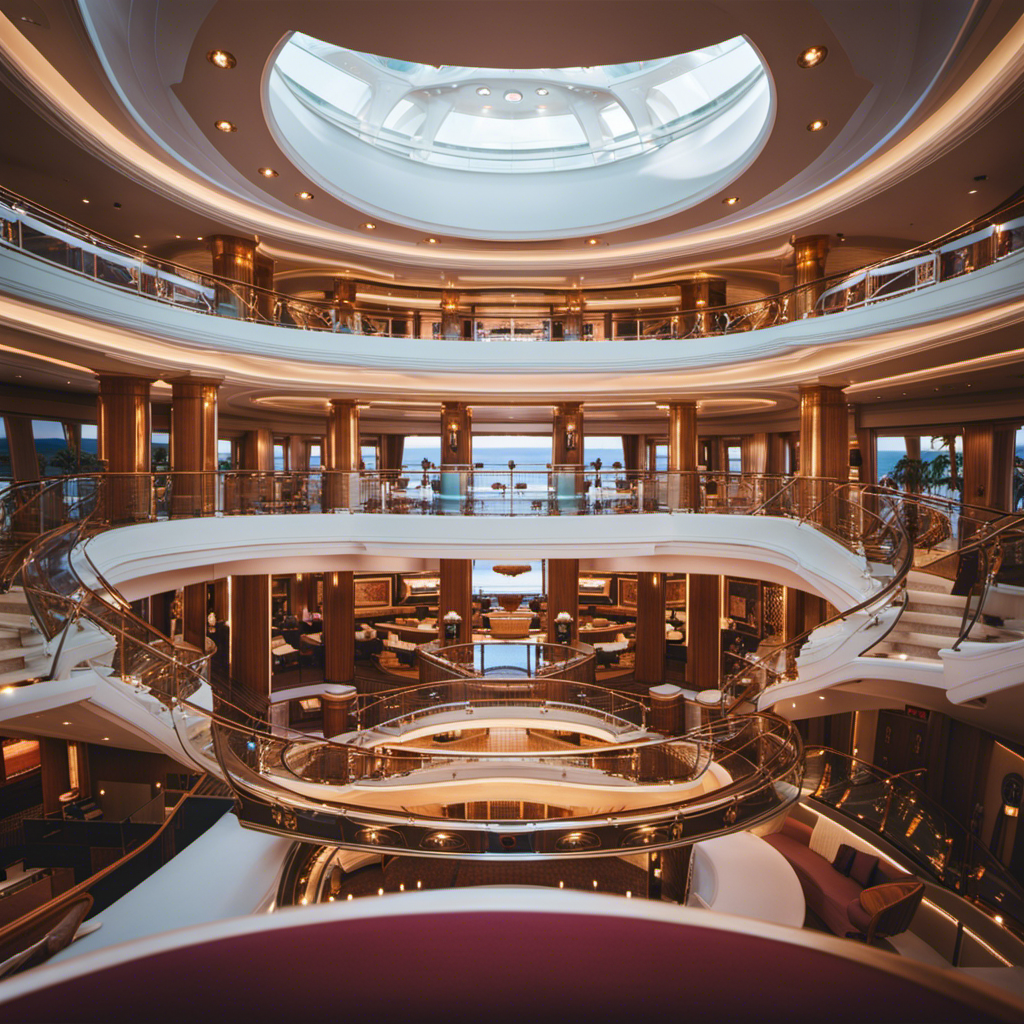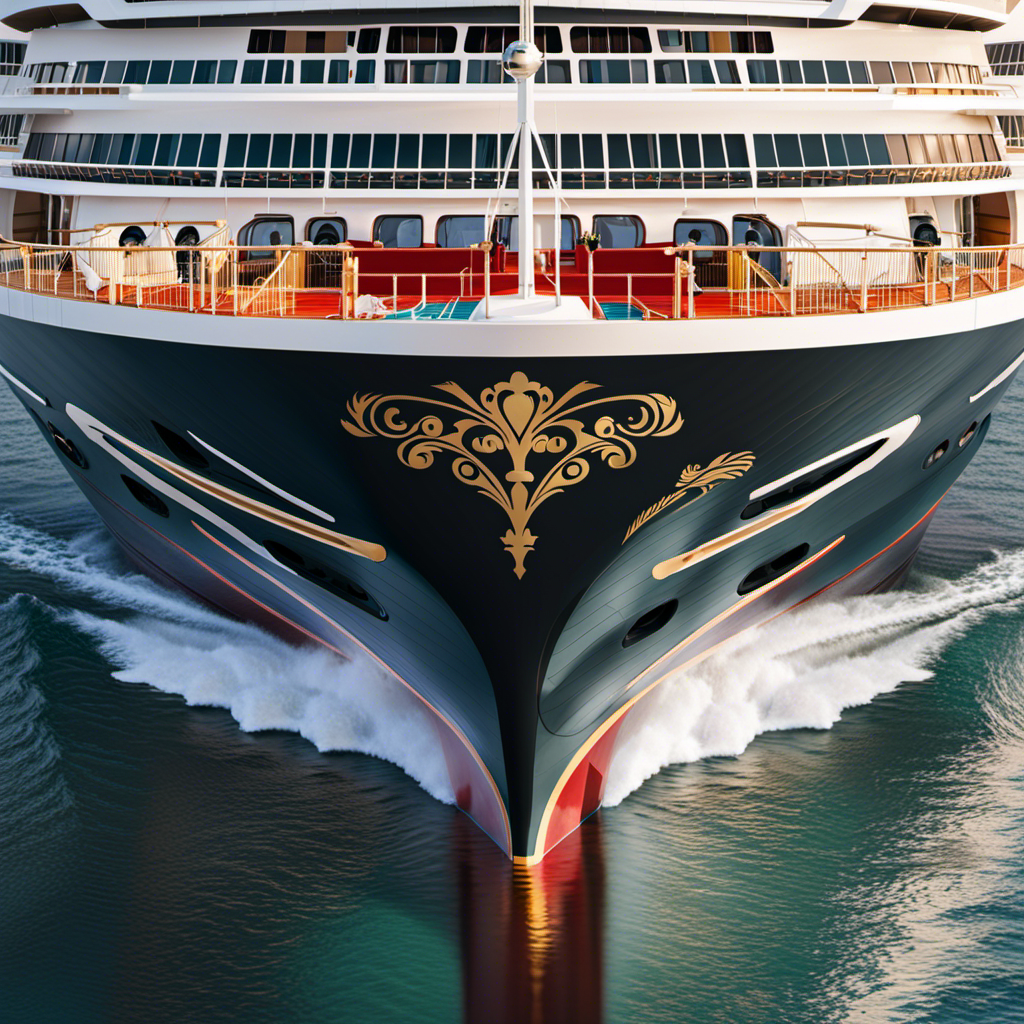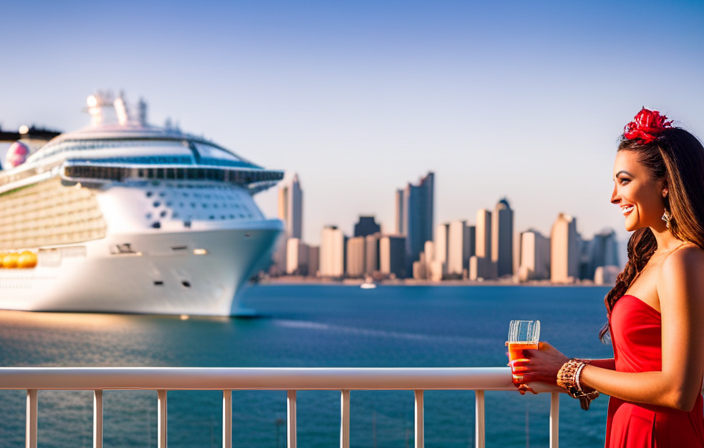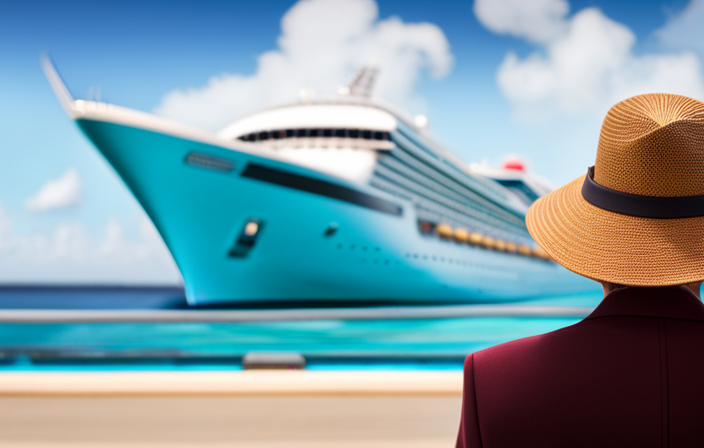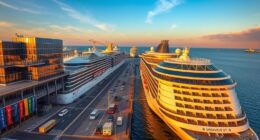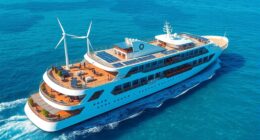Did you know that an average cruise ship can house thousands of guests? It’s intriguing to think about the large number of people these floating cities are able to accommodate.
In this article, I will delve into the world of cruise ship occupancy, exploring everything from historical perspectives to current safety regulations.
Join me as we uncover the fascinating details behind how many people are on a cruise ship and what that means for the passengers and crew alike.
Key Takeaways
- Cruise ships have increased in size and capacity over the years, with the average capacity now around 3,000 passengers and some of the largest ships holding more than 6,000 passengers.
- The maximum occupancy of a cruise ship can vary depending on factors such as size, layout, and safety regulations, with ship design and layout playing a crucial role in determining maximum capacity.
- The crew to passenger ratio determines the level of service and assistance available to passengers, with a higher ratio allowing for better service and assistance.
- Cruise ship tourism has economic impacts such as job creation and increased revenue for local businesses, but also raises concerns about environmental sustainability and social impacts.
Historical Perspective
You might be wondering, ‘How many people are typically on a cruise ship?’ Well, let’s take a look at the historical trends and cultural significance of cruise ship passenger numbers.
Over the years, cruise ships have increased in size and capacity, allowing for more passengers to come aboard. In the early days of cruising, ships could only accommodate a few hundred passengers. However, as technology advanced and demand grew, larger ships were built. By the mid-20th century, some cruise ships could carry over a thousand passengers.
Today, the average capacity of a cruise ship is around 3,000 passengers, with some of the largest ships able to hold more than 6,000 passengers. This increase in passenger numbers reflects the growing popularity and accessibility of cruise vacations.
Now, let’s delve into the specifics of average capacity.
Average Capacity
On an average cruise, it’s common for the ship to accommodate a large number of passengers. The capacity of a cruise ship can vary depending on its size, design, and purpose.
Historical data shows that the average capacity of cruise ships has been increasing over the years, as the industry continues to grow. Industry standards dictate that cruise ships should have enough space to comfortably accommodate all passengers and provide a range of amenities and services.
Cruise lines carefully plan and design their ships to ensure that they can handle the expected number of passengers without compromising on safety or comfort. However, it’s important to note that maximum occupancy can vary from ship to ship, and it is determined by various factors such as the ship’s layout, available cabins, and safety regulations.
With this in mind, let’s explore the concept of maximum occupancy on a cruise ship.
Maximum Occupancy
The maximum occupancy of a cruise ship can vary depending on factors such as its size, layout, and safety regulations. Cruise lines are required to comply with strict safety measures to ensure the well-being of passengers. These measures include having enough lifeboats and life rafts for everyone on board, as well as sufficient emergency exits and evacuation plans.
Additionally, the ship’s design and layout play a crucial role in determining its maximum capacity. Some ships have more cabins and public spaces, allowing for a higher number of passengers. Others may prioritize larger cabins and spacious common areas, resulting in a lower maximum capacity. It is important for cruise lines to strike a balance between providing a comfortable experience for passengers and ensuring their safety.
Speaking of safety, let’s now discuss the crew to passenger ratio.
Crew to Passenger Ratio
The crew to passenger ratio on a cruise ship determines the level of service and assistance available to passengers throughout their journey. This ratio can vary depending on the size and type of the ship, as well as the cruise line’s policies.
Here are three key points to understand about the crew to passenger ratio:
-
High crew turnover: Cruise ships have a constant flow of crew members coming and going. Due to the nature of the industry, crew turnover is common as contracts typically last for a few months. This turnover ensures that the crew remains fresh and motivated.
-
Crew accommodation: Cruise ships have designated areas where the crew lives and works. These areas are separate from passenger areas and are designed to accommodate the needs of the crew, including sleeping quarters, dining facilities, and recreation areas.
-
Service and assistance: A higher crew to passenger ratio allows for better service and assistance. With more crew members available, passengers can expect prompt attention and a higher level of personalized service.
As we delve into the topic of passenger demographics, it’s important to consider how cruise lines cater to different types of travelers.
Passenger Demographics
When planning your cruise vacation, it’s essential to understand the demographics of the passengers you’ll be sharing the ship with. Passenger preferences and cultural diversity play a significant role in shaping the onboard experience.
Cruise lines cater to a wide range of interests and preferences, offering diverse activities, entertainment options, and dining choices. Some passengers may prefer a relaxed and laid-back atmosphere, while others seek more adventurous activities and vibrant nightlife.
The cultural diversity on a cruise ship adds to the richness of the experience, with passengers from different backgrounds and countries coming together to create a truly global community. This blend of cultures enhances the onboard atmosphere, creating opportunities for cultural exchanges and new friendships.
Understanding the passenger demographics allows you to better prepare for your cruise and connect with fellow travelers who share similar interests and backgrounds.
As we explore the impact of cruise ships on local economies, it becomes evident how passenger preferences and cultural diversity can influence the destinations they visit and the activities they engage in, contributing to the economic growth of these communities.
Impact on Local Economies
When discussing the impact of cruise ships on local economies, it’s important to consider both the economic benefits and drawbacks.
On one hand, cruise ships can bring a significant boost to local businesses, such as hotels, restaurants, and tour operators. This results in increased job creation and revenue.
However, there are also potential drawbacks to consider. One is the strain on infrastructure and the environment. Cruise ships require ports and facilities that can handle their size and capacity. This can put pressure on local infrastructure, such as roads, utilities, and waste management systems. Additionally, the environmental impact of cruise ships, including air and water pollution, can be a concern.
Another drawback is the potential dependence on a single industry for economic growth. Relying heavily on cruise ship tourism can make a local economy vulnerable to fluctuations in the industry. If there is a decline in cruise ship visits or a negative event, such as a pandemic or natural disaster, it can have a significant impact on the local economy.
Overall, understanding the economic impact of cruise ships on local communities requires a comprehensive analysis of these factors. It’s important to weigh the benefits against the drawbacks and consider strategies for sustainable and diversified economic growth.
Economic Benefits and Drawbacks
You’ll be pleased to know that there are both economic benefits and drawbacks associated with cruise ship tourism.
On one hand, cruise ship tourism can have positive economic impacts such as job creation, increased revenue for local businesses, and opportunities for economic diversification.
However, there are also some drawbacks to consider. One of the major concerns is the environmental sustainability of cruise ship tourism. The large number of passengers and crew on board each ship can put a strain on local ecosystems, particularly in sensitive coastal areas.
Additionally, the social impacts of cruise ship tourism can be mixed. While it can bring economic benefits to local communities, it can also lead to overcrowding and a loss of authenticity in popular tourist destinations.
Overall, it is important to balance the economic benefits with the potential negative impacts in order to ensure sustainable and responsible cruise ship tourism.
Moving on to the next section, job creation and revenue play a significant role in the cruise ship industry.
Job Creation and Revenue
Job creation and revenue are crucial factors in the cruise ship industry, as they contribute to the economic growth of local communities. The cruise ship industry provides employment opportunities for thousands of people around the world. From ship crew members to onshore staff, there are various positions available in this industry, including captains, engineers, chefs, entertainers, and housekeeping staff. These jobs not only offer a source of income for individuals and their families but also stimulate local economies through the spending power of cruise ship employees. Additionally, the cruise ship industry generates revenue through ticket sales, onboard purchases, and partnerships with local businesses during port calls. This economic activity benefits not only the cruise lines but also the communities they visit, as it supports local businesses and contributes to the overall prosperity of the region. By creating jobs and generating revenue, the cruise ship industry plays a significant role in driving economic growth and development.
As important as job creation and revenue are, safety regulations and evacuation procedures are also essential aspects of the cruise ship industry.
Safety Regulations and Evacuation Procedures
Make sure to familiarize yourself with the safety regulations and evacuation procedures while on the cruise ship. Safety measures are of utmost importance to ensure the well-being of passengers and crew members. Here are three key things to keep in mind:
-
Emergency Drills: Before the ship sets sail, mandatory emergency drills are conducted to familiarize everyone with evacuation procedures. Pay close attention during these drills as they provide crucial information on where to gather, how to use life jackets, and the location of emergency exits.
-
Safety Briefings: At the beginning of your cruise, there will be a safety briefing where important safety information will be shared. Take this opportunity to familiarize yourself with the location of safety equipment, emergency alarms, and evacuation routes.
-
Follow Instructions: In the event of an emergency, it is crucial to follow the instructions given by the crew members. They are trained to handle emergencies and will guide you to safety.
Understanding these safety measures and emergency drills will ensure you are prepared for any unforeseen circumstances while on the cruise ship.
Now, let’s explore the passenger facilities and amenities available on board.
Passenger Facilities and Amenities
The cruise ship offers a variety of facilities and amenities for passengers to enjoy during their voyage. From entertainment options to dining choices, there is something for everyone on board.
For those seeking entertainment, the ship boasts a range of activities such as live shows, concerts, and even a casino. Passengers can also relax and unwind in the ship’s spa, fitness center, or lounges.
When it comes to dining, the ship offers a plethora of options, including buffet-style restaurants, specialty eateries, and formal dining rooms. From casual to fine dining, there is a culinary experience to suit every taste.
As families make up a significant portion of cruise passengers, the ship has special considerations in place to cater to their needs.
Special Considerations for Families
If you’re traveling with your family, you’ll be pleased to know that the cruise ship has special considerations in place to cater to your needs. From special needs accommodations to child-friendly activities, the ship ensures that every member of your family has a comfortable and enjoyable experience.
The special needs accommodations on the ship include accessible cabins, ramps, and elevators to ensure easy mobility for individuals with disabilities. Additionally, the ship offers trained staff to assist guests with special needs, ensuring their safety and well-being throughout the journey.
For families with children, the cruise ship provides a range of child-friendly activities to keep the little ones entertained. From supervised kids’ clubs to dedicated play areas, there’s something for children of all ages. The ship also organizes family-friendly shows, movies, and games, ensuring that every moment spent on board is filled with fun and excitement.
As cruise ships continue to evolve and cater to the needs of families, future trends in cruise ship sizes will likely reflect the increasing demand for more spacious and family-friendly accommodations.
Future Trends in Cruise Ship Sizes
As cruise ship sizes continue to increase, there are several key points to consider.
Firstly, the increasing capacities of these ships have a significant impact on port infrastructure. Ports must be able to accommodate larger vessels and handle the influx of passengers efficiently.
Secondly, the growth in cruise ship capacities also has implications for the passenger experience. With more people on board, it becomes crucial for cruise lines to find innovative ways to ensure a smooth and enjoyable journey for all passengers.
Increasing Cruise Ship Capacities
Imagine how many more people could fit on cruise ships if capacities were increased. With the demand for cruise vacations growing, cruise lines are constantly looking for ways to accommodate more passengers on their ships. Increasing ship sizes is one way to achieve this.
However, it is important to consider the environmental impact of such a decision. Larger ships require more fuel, which leads to increased emissions and contributes to air and water pollution. Additionally, the increased size of the ships can have negative effects on marine ecosystems and coral reefs.
It is crucial for cruise lines to find a balance between meeting the demands of passengers and minimizing the environmental impact of their operations. Moving forward, we must also consider the impact of increasing ship sizes on port infrastructure and the communities that rely on cruise tourism for economic growth.
Impact on Port Infrastructure
The increased demand for larger cruise ships has had a significant impact on port infrastructure. With cruise lines constantly looking to expand their fleets and accommodate more passengers, ports around the world have had to undergo extensive port expansion projects to cater to these behemoth vessels.
These projects involve dredging deeper channels, building larger berths, and improving terminal facilities to handle the increased traffic. However, this port expansion comes with its own set of challenges, particularly in terms of environmental impact. Dredging can disrupt marine habitats and affect water quality, while the construction of larger berths can lead to increased pollution and noise levels.
Despite these challenges, port authorities are striving to strike a balance between meeting the demands of the cruise industry and minimizing their environmental footprint. This focus on sustainability will have implications for the overall passenger experience, as cruise lines and ports work together to create more eco-friendly and efficient operations.
Passenger Experience Implications
To enhance your experience as a passenger, ports and cruise lines are collaborating to implement more sustainable and efficient operations. This collaboration aims to improve passenger satisfaction and provide a wide range of onboard activities.
Here are some key initiatives being undertaken:
-
Enhanced entertainment options: Cruise lines are investing in state-of-the-art theaters, live shows, and immersive experiences to ensure passengers have a variety of entertainment options.
-
Expanded dining choices: Cruise ships are offering a diverse range of culinary experiences, including specialty restaurants, themed dining venues, and options for various dietary needs.
-
Innovative onboard amenities: From water parks and sports facilities to spa and wellness centers, cruise ships are incorporating innovative amenities to cater to different passenger preferences.
-
Digital connectivity: Cruise lines are working to provide high-speed internet access and advanced communication technologies to ensure passengers can stay connected during their voyage.
Frequently Asked Questions
Are There Any Age Restrictions for Passengers on Cruise Ships?
There are age restrictions for passengers on cruise ships due to safety regulations. These restrictions ensure that passengers of all ages can enjoy a safe and secure environment while onboard.
How Do Cruise Ships Handle Medical Emergencies and Provide Healthcare Facilities on Board?
Cruise ships handle medical emergencies by having onboard medical staff available 24/7. They also provide healthcare facilities equipped to handle various medical situations. It’s important to check your insurance coverage to ensure it includes medical expenses while on board.
What Are the Environmental Impacts of Cruise Ships on Marine Ecosystems?
Cruise ships have significant environmental impacts on marine ecosystems. The emissions from these ships contribute to air pollution, and their waste disposal practices can harm marine life and ecosystems.
Can Passengers Bring Their Own Food and Beverages on Board?
Yes, passengers are allowed to bring outside food and non-alcoholic beverages on board most cruise ships. However, there may be restrictions on bringing alcohol, so it’s best to check with the specific cruise line before packing.
Are There Any Special Accommodations for Passengers With Disabilities?
As a cruise ship passenger, I can assure you that there are special accommodations for passengers with disabilities. The ship has accessible facilities and wheelchair accessibility to ensure everyone can enjoy their trip comfortably.
Conclusion
In conclusion, after conducting extensive research, it’s evident that the theory suggesting a large number of people on a cruise ship is indeed true.
With average capacities ranging from a few hundred to several thousand passengers, these floating cities are designed to accommodate a significant number of individuals.
The safety regulations and evacuation procedures in place ensure the well-being of all passengers, while the various facilities and amenities cater to different demographics and preferences.
As cruise ship sizes continue to evolve and grow, the future promises even more extravagant and awe-inspiring experiences at sea.

